
Andrew II, also known as Andrew of Jerusalem, was King of Hungary and Croatia between 1205 and 1235. He ruled the Principality of Halych from 1188 until 1189/1190, and again between 1208/1209 and 1210. He was the younger son of Béla III of Hungary, who entrusted him with the administration of the newly conquered Principality of Halych in 1188. Andrew's rule was unpopular, and the boyars expelled him. Béla III willed property and money to Andrew, obliging him to lead a crusade to the Holy Land. Instead, Andrew forced his elder brother, King Emeric of Hungary, to cede Croatia and Dalmatia as an appanage to him in 1197. The following year, Andrew occupied Hum.

Year 1160 (MCLX) was a leap year starting on Friday of the Julian calendar.

The Sixth Crusade (1228–1229), also known as the Crusade of Frederick II, was a military expedition to recapture Jerusalem and the rest of the Holy Land. It began seven years after the failure of the Fifth Crusade and involved very little actual fighting. The diplomatic maneuvering of the Holy Roman Emperor and King of Sicily, Frederick II, resulted in the Kingdom of Jerusalem regaining some control over Jerusalem for much of the ensuing fifteen years as well as over other areas of the Holy Land.
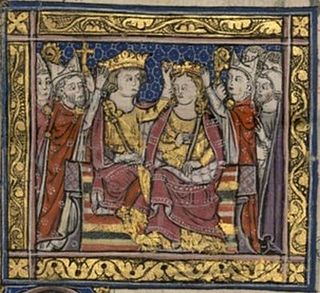
John of Brienne, also known as John I, was King of Jerusalem from 1210 to 1225 and Latin Emperor of Constantinople from 1229 to 1237. He was the youngest son of Erard II of Brienne, a wealthy nobleman in Champagne. John, originally destined for an ecclesiastical career, became a knight and owned small estates in Champagne around 1200. After the death of his brother, Walter III, he ruled the County of Brienne on behalf of his minor nephew Walter IV.
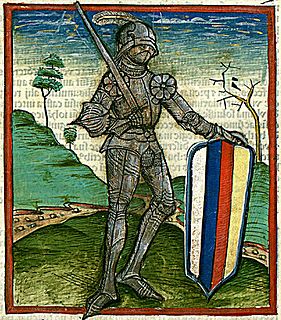
John Hunyadi was a leading Hungarian military and political figure in Central and Southeastern Europe during the 15th century. According to most contemporary sources, he was the member of a noble family of Wallachian ancestry. He mastered his military skills on the southern borderlands of the Kingdom of Hungary that were exposed to Ottoman attacks. Appointed voivode of Transylvania and head of a number of southern counties, he assumed responsibility for the defense of the frontiers in 1441.

Henry Raspe was the Landgrave of Thuringia from 1231 until 1239 and again from 1241 until his death. In 1246, with the support of the Papacy, he was elected King of Germany in opposition to Conrad IV, but his contested reign lasted a mere nine months.
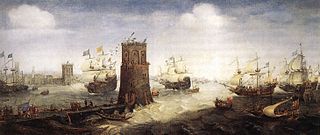
The Fifth Crusade (1217–1221) was a campaign by Western Europeans to reacquire Jerusalem and the rest of the Holy Land by first conquering Egypt, ruled by the powerful Ayyubid sultanate, led by al-Adil, brother of Saladin.
Bohemond IV of Antioch, also known as Bohemond the One-Eyed, was Count of Tripoli from 1187 to 1233, and Prince of Antioch from 1201 to 1216 and from 1219 to 1233. He was the younger son of Bohemond III of Antioch. The dying Raymond III of Tripoli offered his county to Bohemond's elder brother, Raymond, but their father sent Bohemond to Tripoli in late 1187. Saladin, the Ayyubid sultan of Egypt and Syria, conquered the county, save for the capital and two fortresses, in summer 1188.

The Second Battle of Kosovo was a land battle between a Hungarian-led Crusader army and the Ottoman Empire at Kosovo Polje. It was the culmination of a Hungarian offensive to avenge the defeat at Varna four years earlier.

Guérin de Montaigu, also known as Garin de Montaigu or Pierre Guérin de Montaigu, was a nobleman from Auvergne, who became the fourteenth Grand Master of the Knights Hospitaller, serving from 1207–1228. He succeeded the Grand Master Geoffroy le Rat after his death in 1206, and was succeeded by Bertrand de Thessy.
Rupen of Montfort was a Cypriot nobleman, the second surviving son of Humphrey of Montfort and Eschive d'Ibelin.

John of Palisna was a Croatian knight and warrior, prior of Vrana, and Ban of Croatia.
Al Malik Al-Mujahid Asad ad-Din Shirkuh II was the Ayyubid emir of Homs from 1186–1240. He was the son of An-Nasir Muhammad ibn Shirkuh, grandson of Shirkuh and second cousin of Saladin. His domains also included Palmyra and ar-Rahba. Al Mujahid became emir at the age of thirteen when his father died unexpectedly in Homs on 4 March 1186.
Al-Muzaffar II Mahmud was the Ayyubid emir of Hama first in 1219 and then restored in 1229–1244. He was the son of al-Mansur Muhammad and the older brother of al-Nasir Kilij Arslan.
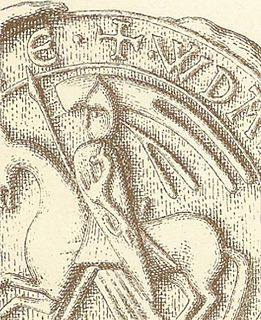
Ulrich II, a member of the House of Sponheim, was Duke of Carinthia from 1181 until his death. He was one of the noble Germans who took part in the Crusade of 1197.
The siege of Jajce took place between 10 July and 24 August 1464, during the Ottoman conquest of Bosnia and Herzegovina, when an Ottoman army under Sultan Mehmed II made a new attempt to retrieve Bosnia and conquer the strategic fortress of Jajce, south of Banjaluka. Despite massive bombardment, the final Turkish assault was heavily repulsed and after hearing that King Mathias of Hungary was approaching with a relief army, Mehmed abandoned the siege.
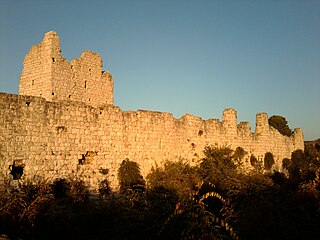
The Priory of Vrana was a monastery near the Croatian town Vrana established as priory of Templars by the Hungarian king Béla II at the beginning of the 12th century. At the beginning of the 14th century the Hungarian perceptories of the Order of Hospitallers took over control of the monastery and established it as their priory.
The battle of Mansurah took place from 26–28 August 1221 near the Egyptian city of Mansurah and was the final battle in the Fifth Crusade (1217–1221). It pitted the Crusader forces under papal legate Pelagius Galvani and John of Brienne, king of Jerusalem, against the Ayyubid forces of the sultan al-Kamil. The result was a decisive victory for the Egyptians and forced the surrender of the Crusaders and their departure from Egypt.

Bertrand de Thessy, also known as Bertrand of Thercy, was the fifteenth Grand Master of the Knights Hospitaller, serving between 1228 and 1230 or 1231. He succeeded Guérin de Montaigu upon his death on 1 March 1228. Thessy was either from France or Italy, most likely the former. He was succeeded by Guérin Lebrun.













